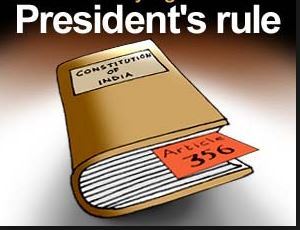PRESIDENT’S RULE
By Osama Irfan Khan
Hyderabad: On Tuesday, Maharashtra Governor Bhagat Singh Koshyari recommended President's Rule in the state noting that a situation has arisen when, even 15 days after the Assembly elections, formation of a stable government is not visible. Soon in the evening, President Ram Nath Kovind signed the proclamation to impose President's Rule on the recommendation of the Union Cabinet.
“The Cabinet considered the report of the Governor and made a recommendation to the President to issue a proclamation under Article 356 (1) of the Constitution,” said a Union Home Ministry spokesperson.
When is President's Rule imposed?
Under the President's Rule the State Government stands suspended and a direct rule of the Centre comes into effect. This is done through the invocation of Article 356 of the Constitution by the President on the advice of the Union Council of Ministers. As stated in Article 356, the President's Rule can be imposed “(1) If the President, on receipt of the report from the Governor of the State or otherwise, is satisfied that a situation has arisen in which the government of the State cannot be carried on in accordance with the provisions of this Constitution…”
The President's rule has been imposed under the following circumstances:
•The State Legislative Assembly is unable to elect a leader as Chief Minister for a time prescribed by the Governor of that state, at the Will of Governor.
•Coalition breakdown following which the Chief Minister has minority support in the house and the Chief Minister fails/will definitely fail to prove contrarily, within a time prescribed by the Governor of that state.
• Due to a vote of no-confidence in the legislature, there is loss of majority in the Assembly.
•Elections get postponed because of inevitable reasons like war, epidemic or natural disasters.
•Article 356 states that the President can invoke President Rule in a state based on the report of the Governor if the state machinery/legislature fails to abide by Constitutional norms.
The President’s Rule needs to be approved by both the houses of the Parliament within a period of two months.
What is the duration of the President's Rule?
If approved by both the houses of the Parliament i.e. Lok Sabha and the Rajya Sabha, within a period of two months, President's Rule can continue for six months.
The 44th Amendment Act of 1978 introduced a new provision regarding the power of the Parliament to extend the president's rule in a state. This provision says that the President's Rule can only be extended over a year every six months under the following conditions:
•There is already a national emergency throughout India, or in the whole or any part of the state.
•The Election Commission certifies that elections cannot be conducted in the particular state.
How is the President's Rule withdrawn?
The President’s Rule can be withdrawn through a succeeding proclamation in case the leader of a party/coalition proves absolute majority(majority of more than 50% of the total membership of the house) in the Legislature by producing letters of support from the majority of members of the Assembly and stakes his claim to form a government. Unlike the process of imposition, the revocation does not demand Parliament’s approval.